In this article, we will delve into a fascinating comparison between two identical vehicles with different power outputs. One vehicle boasts 1000 horsepower (HP) and 500 pound-feet of torque, while the other has 500 HP and 1000 pound-feet of torque. A common question that arises is, which one would win in a quarter-mile drag strip race? Is it the one with higher horsepower or the one with higher torque? This question leads us to a deeper understanding of horsepower, torque, and vehicle dynamics, and possibly a headache!
To make the comparison fair, we will assume that the peak horsepower and peak torque values occur at the same RPM for both vehicles. For instance, let’s say the peak horsepower occurs at 5000 RPM and peak torque occurs at 2500 RPM. However, there is a catch. One of these vehicles or engines is actually impossible to exist, and to understand why we will use a simple formula that relates horsepower, torque, and RPM.
By the end of this article, you will have a more profound understanding of the relationship between horsepower and torque, and how they affect vehicle performance. We will use a simulation software to compare the performance of both vehicles over a quarter-mile drag strip and under different conditions.
Let’s get started by understanding the key concepts of horsepower and torque, and how they are interconnected.
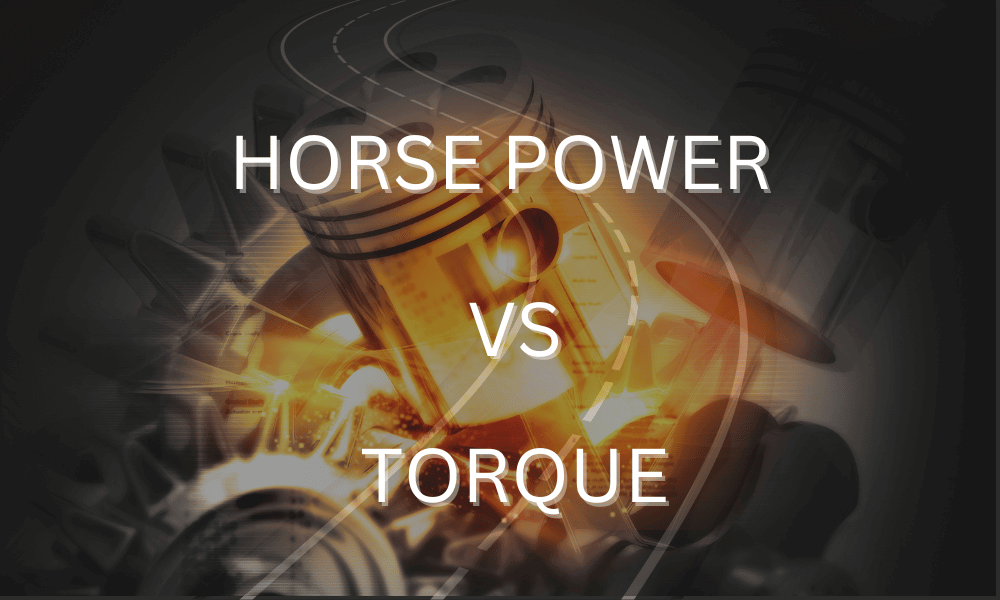
Horsepower is a unit of power that is commonly used to measure the output of engines and motors. It was originally coined by James Watt in the 18th century to compare the power of steam engines with the power of draft horses. One horsepower is equivalent to 745.7 watts.
In the context of vehicles, horsepower refers to the power that the engine produces. It is a measure of the engine’s ability to do work over time. The more horsepower an engine has, the more work it can do in a given amount of time.
Torque is a measure of rotational force. It is the force that causes an object to rotate about an axis. In the context of vehicles, torque refers to the rotational force that the engine produces. It is a measure of the engine’s ability to do work.
The amount of torque that an engine produces is directly related to the amount of air and fuel that it can burn in its cylinders. The more air and fuel that an engine can burn, the more torque it will produce.
Horsepower and torque are closely related. In fact, they are two sides of the same coin. Horsepower is a measure of the engine’s ability to do work over time, while torque is a measure of the engine’s ability to do work.
The following formula can express the relationship between horsepower and torque:
Horsepower = [ Torque (lb-ft) * RPM ] / 5252
Where:
This formula shows that horsepower and torque are directly related. As the torque produced by the engine increases, so does the horsepower. Similarly, as the RPM of the engine increases, so does the horsepower.
Both horsepower and torque are important for vehicle performance. Horsepower is important for achieving high speeds, while torque is important for acceleration and pulling power.
In summary, horsepower and torque are two sides of the same coin. They are both measures of the engine’s ability to do work, but they are important for different aspects of vehicle performance. Horsepower is important for achieving high speeds, while torque is important for acceleration and pulling power.
In this experiment, we start by selecting a vehicle, an ’84 Honda CRX. Once the vehicle is selected, the rest of the data gets auto-populated. We then choose a 2.2 liter, street-oriented, 4-cylinder engine. However, this doesn’t matter much as we will define custom horsepower and torque values and curves in the next window.
We input our peak horsepower, its RPM, and our peak torque and the RPM at which it occurs. Initially, we start with a torque-biased engine to see what it can do. To simplify our comparison and keep the focus on the engine, we choose a direct drive transmission, meaning the engine is directly driving the wheels with a 1:1 gear ratio, essentially eliminating the transmission from the equation. We are comparing the engines and their horsepower and torque to see what kind of performance they can generate over a quarter-mile drag strip.
For the tires, we choose stock street tires and wheels, a conservative driving style, and typical track conditions.
The result for our torque-biased engine is 13.6 seconds. Next, we test our horsepower-biased engine, keeping everything the same except for the horsepower and torque. The result is 19.4 seconds, which is significantly slower despite having 1000 horsepower. This teaches us an important lesson: horsepower and torque are interconnected. If you have high horsepower but disproportionately low torque, your performance will be subpar.
As observed in the graphs, our vehicle never even manages to reach 100 miles per hour. It launches at around 4000 RPM, but the RPM immediately falls off. There simply isn’t enough torque to sustain the desired RPM.
To make our vehicle more realistic, we introduce gear ratios into the game and choose a normal street final drive ratio of 3:1. This means we multiply the torque by three times and reduce the output rotation speed also by three times. With a final drive ratio of 3:1, the quarter-mile time of our horsepower-biased engine becomes a very respectable 11.9 seconds. Our torque-biased engine does it in 11.8 seconds, making the race extremely tight.
However, observing the graphs, we learn that the torque-biased vehicle is barely winning due to a complete lack of traction. The tires are practically spinning the entire time, indicating that the torque-biased vehicle has too much torque, overpowering the tires and breaking traction.
To improve traction, we choose mild race tires. This results in wheel spin only half the time and improves our time to a very respectable 10 seconds flat for the torque-biased engine. The horsepower-biased engine, with zero wheel spin, improves to 11.1 seconds but is still slower than the torque-biased engine because it still has too little torque.
We then introduce a proper transmission in addition to a final drive to see what happens. We choose a basic four-speed manual, and our time improves to a very respectable 9.7 seconds for the horsepower-biased engine and 10.4 seconds for the torque-biased engine. The horsepower-biased engine wins now because, with the torque multiplication from the gears of the final drive and the transmission, it can finally make use of its 10,504 RPM.
We then imagine a scenario where the owner of the CRX is using their car to build a house and has loaded the car up with a lot of bricks, making the car weigh 6,000 pounds. Now, our torque-biased vehicle manages a time of 12.4 seconds, and our horsepower-biased vehicle manages a time of 12.8 seconds. Torque wins again.
To exaggerate the effect of weight on performance, we remove the torque multiplying effects of the transmissions and return everything to a 1:1 gear ratio. Now, the horsepower-biased engine does 35 seconds, and the torque-biased engine does 24 seconds, resulting in a 9-second difference.
The experiment yielded several key insights into the relationship between torque, horsepower, and vehicle performance.
The first and most important observation is the interconnectedness of horsepower and torque. Despite having 1000 horsepower, the horsepower-biased engine performed significantly worse than the torque-biased engine, taking 19.4 seconds to complete the quarter-mile compared to the torque-biased engine’s 13.6 seconds. This indicates that having high horsepower but disproportionately low torque results in subpar performance. The vehicle with the horsepower-biased engine never even managed to reach 100 miles per hour, and the RPM immediately fell off after launching, indicating that there wasn’t enough torque to sustain the desired RPM.
The introduction of gear ratios into the experiment highlighted their importance in vehicle performance. Gear ratios are essentially torque multiplication devices. A 3:1 final drive ratio, for example, multiplies the torque by three times and reduces the output rotation speed by three times. With a 3:1 final drive ratio, the quarter-mile time of the horsepower-biased engine improved significantly to 11.9 seconds, while the torque-biased engine completed it in 11.8 seconds. This made the race extremely tight, indicating that with the proper gear ratios, a horsepower-biased engine can perform almost as well as a torque-biased engine.
The experiment also highlighted traction issues. The torque-biased vehicle experienced a complete lack of traction initially, with the tires practically spinning the entire time. This indicated that the vehicle had too much torque, overpowering the tires and breaking traction. This issue was partially resolved by switching to mild race tires, which improved the quarter-mile time to 10 seconds flat for the torque-biased engine and 11.1 seconds for the horsepower-biased engine.
The introduction of a proper transmission, in addition to a final drive, further improved performance. With a basic four-speed manual transmission, the horsepower-biased engine completed the quarter-mile in 9.7 seconds, while the torque-biased engine took 10.4 seconds. This result indicates that with the right transmission and final drive, a horsepower-biased engine can outperform a torque-biased engine.
Finally, the experiment demonstrated the effect of weight on performance. When the vehicle’s weight was increased to 6,000 pounds, the torque-biased vehicle completed the quarter-mile in 12.4 seconds, while the horsepower-biased vehicle took 12.8 seconds. This indicates that torque is more important than horsepower for heavy loads. When the torque multiplying effects of the transmissions were removed, the difference in performance became even more pronounced, with the horsepower-biased engine taking 35 seconds and the torque-biased engine taking 24 seconds to complete the quarter-mile.
The experiment demonstrated that both torque and horsepower are crucial for vehicle performance and that finding the right balance between the two is key. While a torque-biased engine may perform better under heavy loads, a horsepower-biased engine can outperform it with the proper transmission and final drive. Ultimately, the key to optimal performance lies inis selecting the appropriate transmission, final drive, and tires for the vehicle’s intended use.
The latest BMW 5 Series is called the G30 in the form of a sedan, G31 in the form of a wagon and G38 in the form of a long-wheelbase sedan, the latter reserved mainly for the Chinese market. However, the underpinnings, engines, gearboxes and the rest are fairly the same in these versions of the 5 Series and GT Kraft engineering team has developed a performance module for the BMW 520d tuning that pushes up the power of the car in any iteration.
The 520d we tuned is an example of the latest version of the 5 Series, on sale from 2017. It is powered by BMW’s entry level turbocharged diesel engine called B47 which produces 190 hp and 400 Nm (295 lb-ft) of torque from 1,750 revs.
This makes it more of a sensible choice than a sporty one, as it reaches 100 km/h (62 mph) in 7.7 seconds. However, its relaxed cruising ability and low fuel consumption make it a very popular choice.
But this sensible car can be faster and more efficient at the same time and all that without any hardware modifications!
This is done by the use of our advanced performance module which optimizes the signal sent to the ECU and thus improves performance and efficiency without hampering safety or tampering with the stock parts. All hardware stays the same, the car boasts OEM safety, but it also has more power and torque.
The module is developed by our expert engineers with decades of experience in Formula 1 and extreme tuning. They understand the importance of safety and efficacy and are able to deliver both.
The tuning process for the BMW 520d started by a dyno test which showed us the wheel horsepower of the stock car. As you can see in the image below, the measured wheel horsepower was just slightly lower than the factory rating – it was 186.5 horsepower.
Similarly, the torque was measured at 397 Nm (293 lb-ft), so the factory rating was pretty accurate.
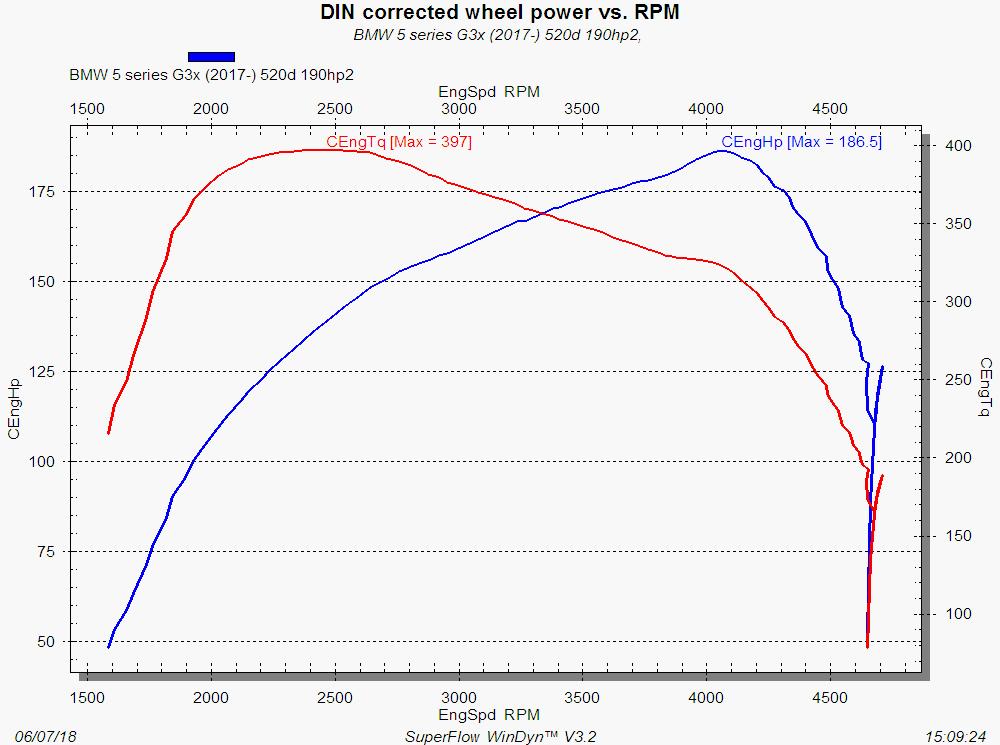
The dyno runs also gave us several different pieces of information necessary for the development of a safe, reliable and efficient tuning.
After that, our engineers developed the software for our performance module for the BMW 520d. When connected to the car, the module gathers the information from the vehicle’s sensors, optimizes it and sends it to the ECU. The optimization results in a slight increase in turbo pressure, which is inevitably followed by an increase in the fuel delivery and injection advancement.
These three adjustments need to work together! The amounts of fuel and air need to be proportioned in the most efficient way for every section of the rev range. Similarly, the added amounts of air and fuel enable us to advance injection of fuel which results in earlier ignition and improved throttle response.
All three adjustments need to be carefully tailored and measured on the dyno. For example, if injection is too advanced, this can cause serious damage to the engine. This is why our experienced engineers and top equipment play a major role in the safety of our tuning solutions.
The result of this tuning is a noticeable increase in power, torque, throttle response and fuel efficiency.
As you can see in the image below, the power rating at the wheels was increased to 217 hp, while torque rose to 450 Nm (332 lb-ft). The same amount of torque and power is now available lower in the rev range which means that the car accelerates effortlessly and needs less throttle for the same speed. This improves fuel efficiency and makes the car run smoother.
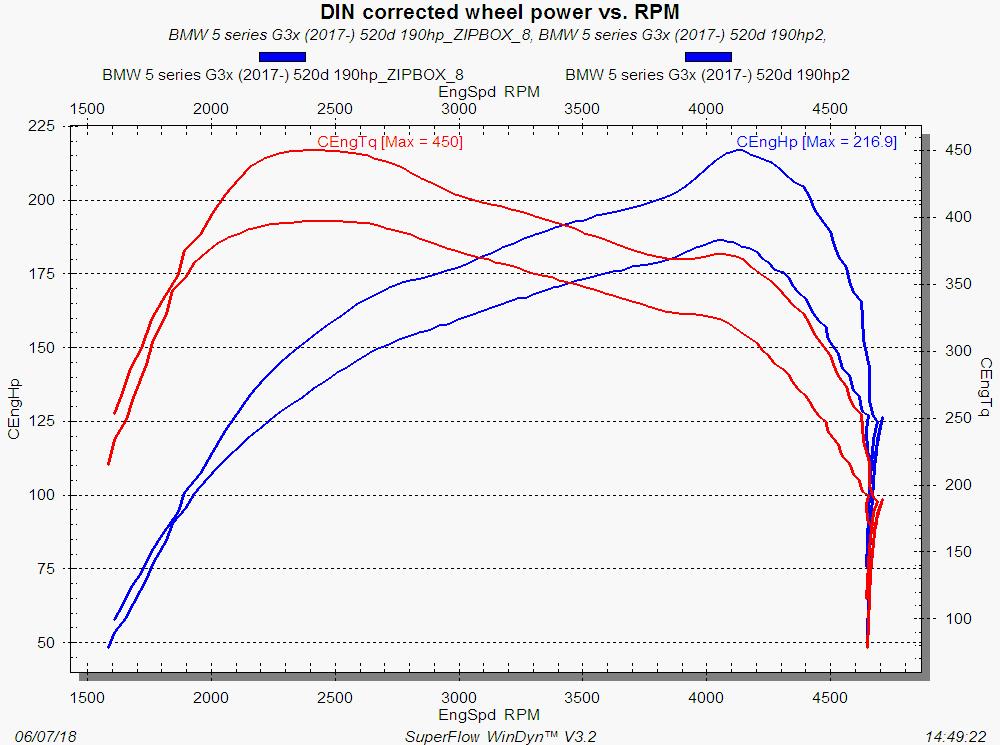
The injection advancement makes the car react to the pedal push faster and the added torque adds to the feeling of instantaneous response from the engine.
Our tests also show that the modification is very reliable and completely safe for the vehicle. No internal parts are changed, there are no hardware additions, OEM ECU hasn’t been tampered with safety is at the OEM level.
The entire modification is tucked away in our stylish performance module and its installation is as easy as can be. All you need to do is disconnect the ECU from the sensors and connect the performance module between the sensors and the OEM ECU.
The performance module comes with the plugs necessary and all you need to do is connect them to the matching places.
It is worth noting that more power is possible with this engine with just a few basic hardware changes such as new intake and exhaust parts. These would allow for a better air flow and give more room for software modifications.
Do you own a G3x BMW 5 Series? Would you like more power? Contact us and enjoy the safest performance boost available on the market.
GT Kraft has moved the boundaries once again! We present you with the latest Audi’s 3.0 TFSI tuning. This six-cylinder engine has several different applications and its power rating varies depending on the model it powers. It is used in the Audi models A6, A7, A8, Q7, S4 and S5 and it employs completely new digitalized signal processing in the form of SENT protocol.
Until recently, cars whose engines operate based on SENT protocol couldn’t be tuned. However, our engineers with experience in Formula 1 engineering have developed OEM quality performance module tuning for these engines as well. Here we present you with our tuning for the SENT 3.0 TFSI.
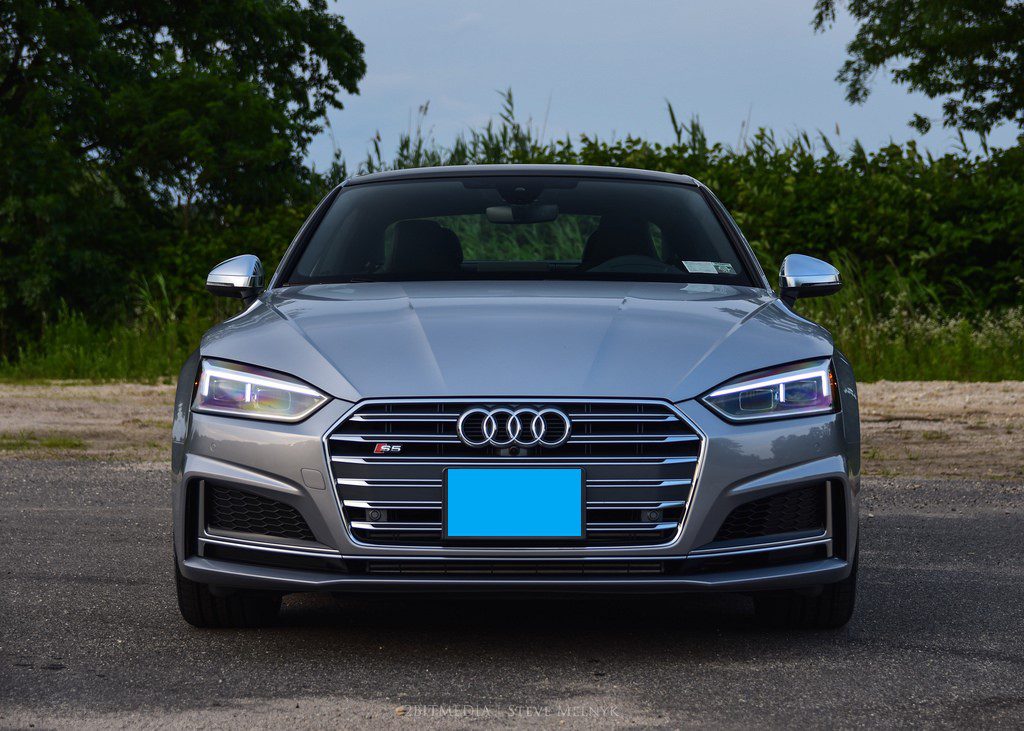 The car we used was the latest Audi S5 TFSI with twin-scroll turbocharged V6 producing 354 hp and 500 Nm (369 lb-ft) of torque. The result of our tuning came to massive 428 hp and 600 Nm (443 lb-ft) of torque. This kind of an increase brings the S5 a lot closer to the far more expensive RS5!
The car we used was the latest Audi S5 TFSI with twin-scroll turbocharged V6 producing 354 hp and 500 Nm (369 lb-ft) of torque. The result of our tuning came to massive 428 hp and 600 Nm (443 lb-ft) of torque. This kind of an increase brings the S5 a lot closer to the far more expensive RS5!
This S5 was already a very capable performance vehicle, but now with more than 400 hp the stylish coupe becomes a real supercar.
Tuning for the 3.0 TFSI is specifically developed for each of the applications. It comes in a neatly styled performance module that is very easy to connect. The extra power comes from our performance module that is connected directly to the ECU. The performance module reads the digital information from the sensors, processes it and sends the optimized information to the ECU.
There are no physical alterations to the stock ECU. The OEM electronic components remain untouched so the car bears OEM safety. All of the information from the sensors is decrypted, optimized, encrypted again and transferred to the OEM ECU by our performance module. This means that the OEM safety is preserved and that the stock electronic components are not tampered with.
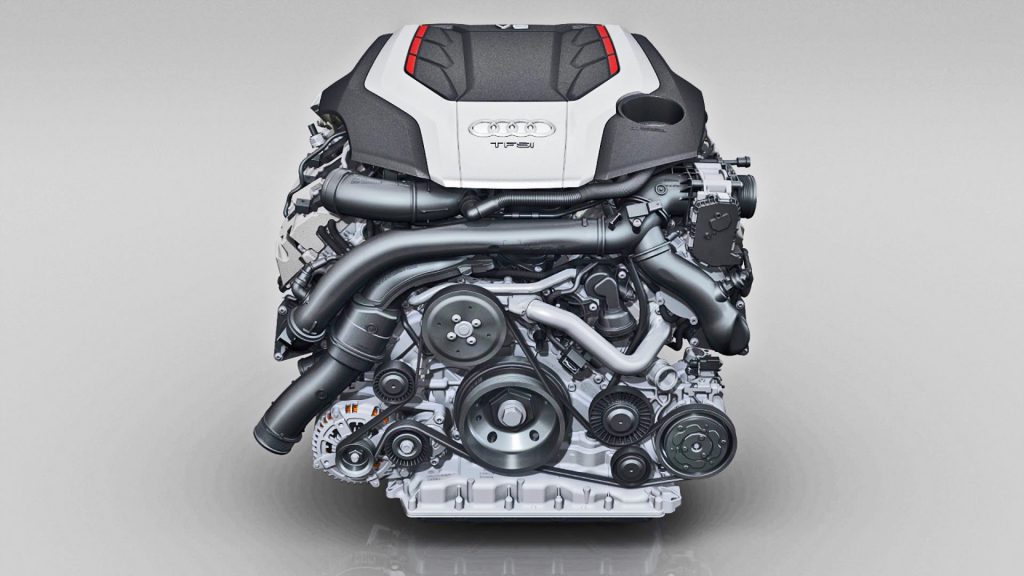 Aside from the S5 we also tune other cars with the 3.0 TFSI. The same engine is used in the S4, A6, A7, A8 and Q7, albeit with different power ratings, depending on the model it powers. For example, in the Audi Q7 the 3.0 TFSI has the power rating of 333 hp and 440 Nm (320 lb-ft) of torque. It propels the massive SUV to 100 km/h (62 mph) in just 6.1 seconds. Our performance module raises the power rating to 407 hp, effectively dropping the acceleration time to under 6 seconds.
Aside from the S5 we also tune other cars with the 3.0 TFSI. The same engine is used in the S4, A6, A7, A8 and Q7, albeit with different power ratings, depending on the model it powers. For example, in the Audi Q7 the 3.0 TFSI has the power rating of 333 hp and 440 Nm (320 lb-ft) of torque. It propels the massive SUV to 100 km/h (62 mph) in just 6.1 seconds. Our performance module raises the power rating to 407 hp, effectively dropping the acceleration time to under 6 seconds.
SENT is an acronym that stands for Single Edge Nibble Transmission. It is the most advanced, completely digitalized signal transmission protocol used to transfer high resolution information from a sensor to the ECU. Digitalization of the sensor signal means that the information is reliable, completely resistant to any electromagnetic interference and more accurate, which enables us to develop finely tuned optimizations.
SENT can also transmit more parameters at the same time, which makes it far more efficient. Speaking of efficiency, SENT protocol is noticeably more cost efficient than the old system.
In short, SENT is better, faster, more reliable, more efficient, more precise, resistant to interference and inexpensive. This is why it is expected that it will become industry standard in the near future. It has now spread to several VW GTI models, and a number of Audi and Porsche cars with both petrol and diesel engines.
As new model years appear, other manufacturers are bound to switch to SENT because of its huge advantages. As that happens, we will be here to help you unleash the full potential of your modern car with our SENT performance modules.
EcoBoost engines were developed to provide Ford with an answer to the downsizing trend of the competitors. They were designed to provide power that could match larger naturally aspirated engines, but far better fuel efficiency and lower emissions.
Basically, they were supposed to be sensible.
However, this downsizing means that there are no V8 engines. Yes, in America also. Ford EcoBoost engines have no V8 option available. The biggest engine is a 3.5 l V6. This was a very bold move for Ford, especially since the V6 is supposed to propel some of the most revered vehicles in the US.
Still, Ford was confident that the EcoBoost was the future that it actually considers this engine lineup a proper replacement for 6l+ naturally aspirated engines, diesels and even hybrids. They even put it in the likes of the Ford GT – a successor to the legendary Ford GT40 and the top sports car from Ford at the moment.
However, if it was supposed to replace all of those old engines, then that means it is also in the heavy-duty machines such as the F-150 Raptor. That is a workhorse of a vehicle, but the figures were on the side of the small EcoBoost. It produces more power than the 6.2 l V8 it replaced.
Ford had an entire campaign which served to show how capable the V6 EcoBoost is. They had a series of videos where the Raptor was used to pull logs in the heaviest of terrains and it did it without a glitch.
Well, we got one of these now. GT Kraft experts under the watchful eye of Wim Essing developed a tune for the Raptor. We’ve tinkered with it aiming to get the most out of it while keeping it safe and reliable.
We started off by measuring its power and torque it came with. The spec sheet says that the V6 in the Raptor produces 450 hp and 691 Nm of torque. However, these are crankshaft figures. Figures at the wheel are always lower and our measurements showed that they are at 400.8 hp and 571 Nm of torque.
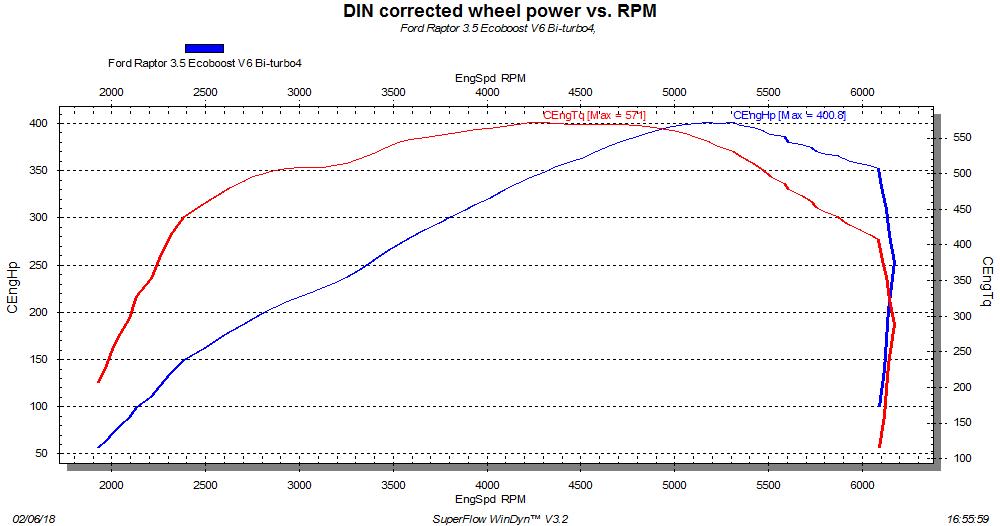
In total, we added three parts:
– cold air intake
– aftermarket exhaust
The cold air intake and exhaust can be sourced from several different aftermarket units manufacturers. Depending on the model we are tuning and the desired results, the customer can choose between several of these. Exhausts in particular can make a huge difference in sound and the choice depends on your preference. On the performance front, all of them are top notch, so the benefits will be at about the same level.
The GTK Performance ECU, on the other hand, is in-house developed by us to enhance the way that the OEM ECU works.
First of all, it takes into account the added benefits from the intake and exhaust. Our software setup tells the ECU to increase the turbo pressure. This way the engine gets more air.
In order to make the engine work as it should, we also adjust the software so that it increases the amount of fuel sent into the engine. This is very important since the ratio of air and fuel needs to be at exactly the right level in order to provide thorough combustion. This needs to be done across the rev range.
Lastly, the added air and fuel greatly increase performance, so that makes room and calls for an adjustment in ignition timing. This is done to ensure better combustion, but it also has another benefit – it makes throttle response noticeably faster. The Raptor reacts to the pedal push a lot faster after the advancement in ignition timing.
It is important to note that neither of these adjustments should be taken too far. The added fuel and air increase the levels of stress that the engine parts endure, so knowing the limits is essential.
Similarly, advancing ignition timing as much as possible gives great benefits and a much improved driving feel, but taking it too far can seriously damage the engine.
The intake and exhaust parts are also added to make the engine breathe easier.
This is why all our adjustments are done in increments and carefully monitored. We tested the car on our SuperFlow dynamometer and made sure each step of the way and the end product were as safe as OEM setup.
As explained, power and torque at the wheels were at 400.8 hp and 571 Nm. After the first set of adjustments, the figures got a very healthy bump. As you can see in the image below, the torque was at 691 Nm and the power at the wheels rose significantly to 477 hp.
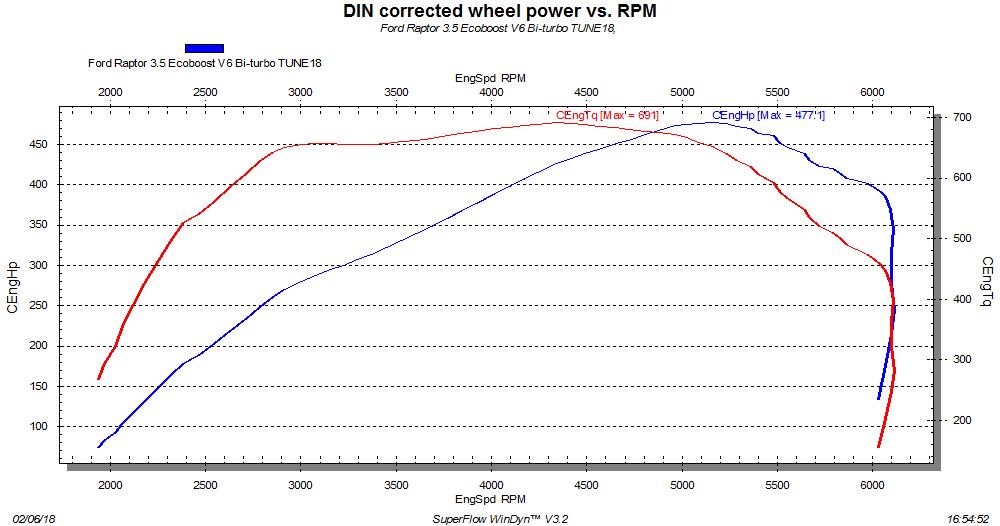
Data obtained from testing showed us that the torque curve could be significantly wider, so we performed further adjustments and increased the torque from under 3,000 rpm and top power. However, a small notch (2 Nm) from the top torque level was lost and we performed another set of adjustments.
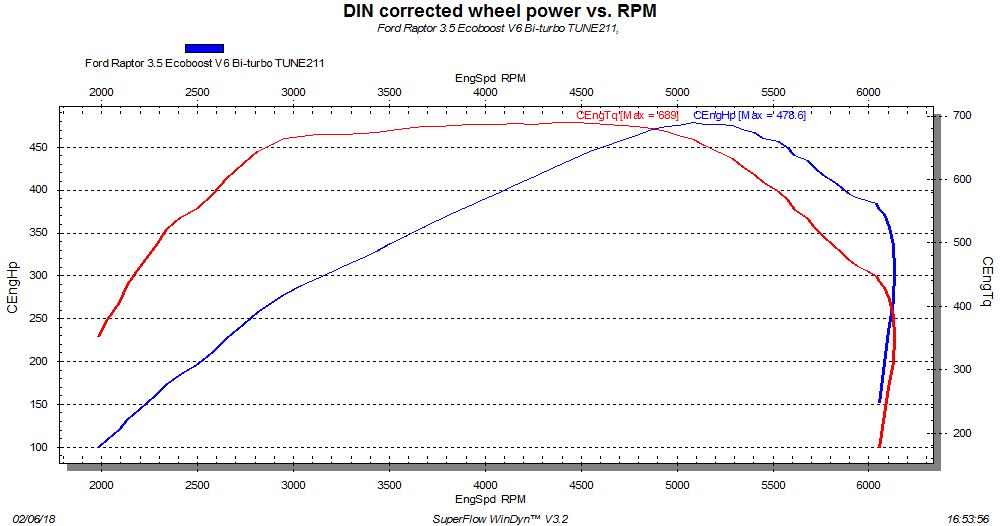
After this, we gained 700 Nm of torque and 481.3 hp. However, there was room for more.
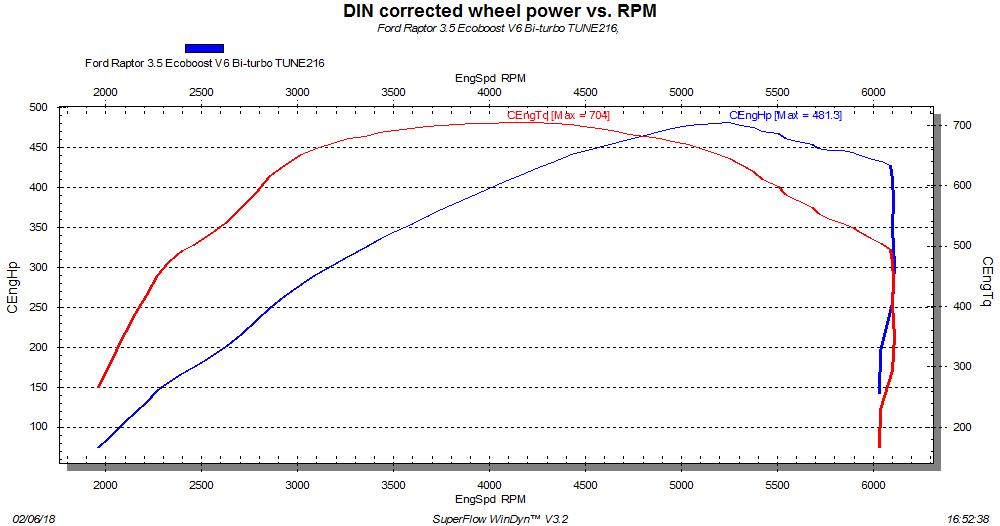
The final set of adjustments resulted in massive 736 Nm of twisting force and exactly 500 hp from the impressive 3.5 l V6 EcoBoost.
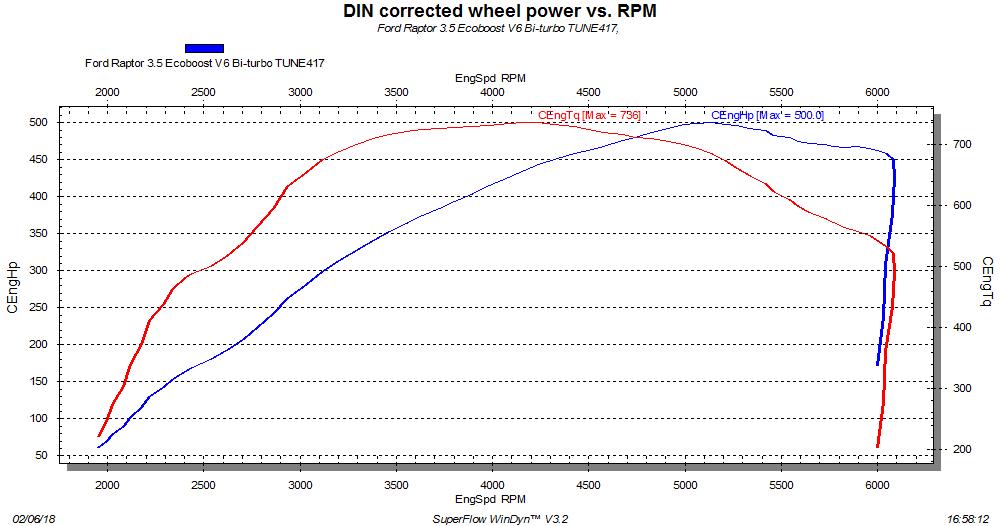
This is a huge improvement and one that is completely safe for the engine, gearbox and all the parts. Getting 100 hp and 165 Nm more without changing engine internals is a massive gain, but also a reminder why meticulous testing, extensive knowledge and experience and thorough dedication are imperative in the tuning business.
This success makes us wonder how far we could take the EcoBoost V6 with an engine rebuild.
Do you have a car with 2.7 or 3.5 l EcoBoost V6? We offer tailored tuning programs that will make your car significantly faster without jeopardizing safety and reliability. Contact us for more information.
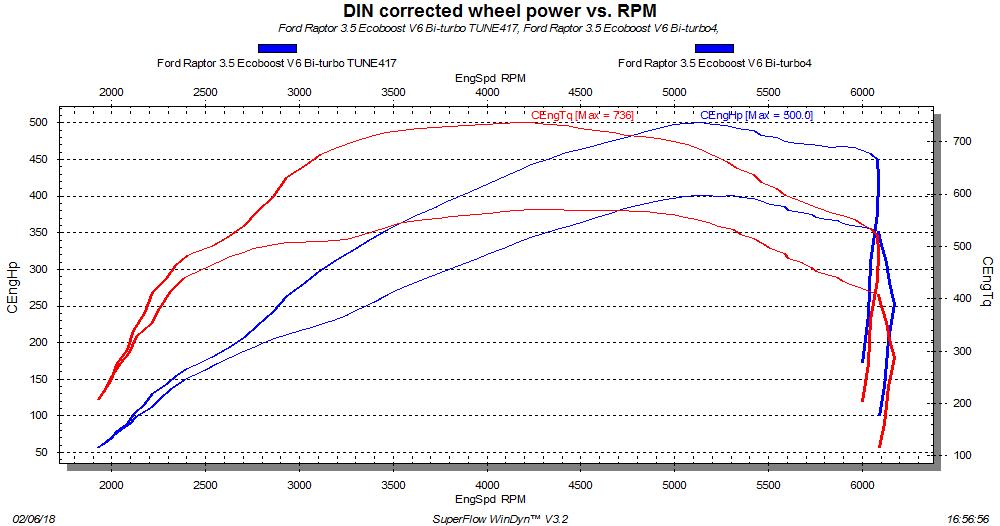
Mercedes now offers the C-Class AMG models with the latest 4 l V8 that produces 510 bhp in the C63 S. A very similar engine is used in the AMG GT, E63 AMG and the latest S63 AMG and it features “hot inside V” setup that reduces turbo lag by placing the exhaust and turbo inside the cylinder banks. Aside from the amazing power rating which goes all the way up to 612 bhp in its bigger brothers, the engine also provides loads of torque (516 lb-ft in the C63 S) from very low revs, which makes the C63 S a great everyday ride, as well as an amazing sports car.
But there are even more benefits of the new engine. Reducing the size and adding biturbo setup, AMG engineers reduced fuel consumption by 32% and at the same time improved performance, compared to the previous V8 engine used by AMG.
Performance of the car is astonishing. Acceleration to 62 mph takes about 4 seconds and the top speed is limited to 155 mph, or 180 mph with the optional driver’s performance pack. The latter figure is also electronically limited, so the car can go even faster with the limiter off.
So, the C63 AMG is an amazing sports car with incredible performance, clean and elegant styling that also gives more than enough hints of the power under the hood and all that with an everyday practicality and fuel efficiency that surpasses those of cars that offer far fewer grinning opportunities.
It can’t get much better than that, right? Actually, it can get a lot better!
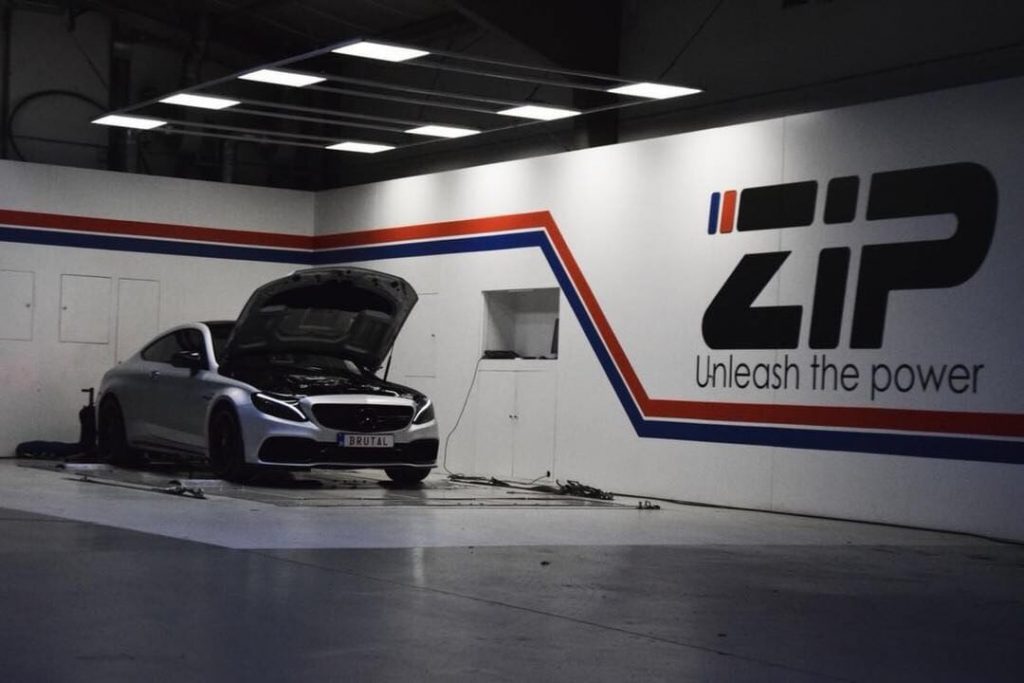
The stage 1 includes several changes all of which are based on altering the ECU software without adding any new parts.
The first step is consisted of increasing the amount of air fed to the engine by the turbocharger. The one that inevitably accompanies it is adjusting the amount of fuel to accommodate the increase in the amount of air in all regimes of operation. This is a software tweak that needs to be done with care since going too far can cause serious damage to the engine and accompanying parts.
Also, the two adjustments need to complement each other at every point. This is why adjusting the amount of fuel and air to provide a significant but safe improvement requires complete knowledge about each and every performance part in the car, as well as extensive testing on the finest equipment. This is especially so in cars such as the C63 AMG, since the parts in such a performance car already withstand significant stress.
The next step, which is also a part of the stage 1, is a change in ignition timing. Ignition timing is advanced which helps the engine burn the extra fuel and air. Aside from providing better combustion, this also improves throttle response, so the car reacts noticeably faster when you press the pedal. However, this is another aspect that requires care and knowledge. Advancing the ignition too far causes serious damage to the engine internals, so technical knowledge and extensive testing are paramount.
The icing on the stage 1 cake is the removal of the speed limiter which allows the C63 S to unleash its full potential and go faster than many performance two-seaters.
Speaking of improved performance, after the stage 1 the C63 S produces 581 hp and 604 lb-ft of torque. That is a very noticeable, but also completely safe, performance increase that comes from stock parts alone.
But, there’s more.
The changes for the stage 2 include hardware additions such as new exhaust and intake parts. These are designed to accommodate additional software changes. Where stock parts start to lack efficiency, aftermarket steps in.
We offer performance exhausts from the most renowned manufacturers, as well as cold air intake parts.
These improve air flow to and from the engine and allow our engineers to adjust the ECU software for even more power.
Aside from this, the new exhaust also gives a more distinctive soundtrack that will make your car sound unique as it leaves stock machines behind.
This upgrade, together with the ECU software tweak, results in an even higher power rating that now breaks the 600 hp barrier, reaching 609 hp and 630 lb-ft of torque.
With these upgrades, the C63 S has the power and torque of the E63 S, while being lighter.

If you want to make more of an impression, you can opt for our additional tuning options. Your C63 S can create those amazing pop&bang sounds and flames when you lift your foot off the throttle.
This modification ensures that even when you lift your foot off the throttle, the turbo and fuel delivery do not stop working immediately.
Another change performed in pop&bang tuning is retardation in the ignition timing, which is targeted to occur at a certain rev range and in low load conditions, which gives us the chance to provide you with the improvement in performance when you press the pedal hard, but also great pops, bangs and flames when you lift your foot off the throttle.
Aside from the healthy gurgling and bangs, this also means that when you press the pedal again, there is no need to wait for the turbo to spool up. The boost is readily available instantly and there is no turbo lag. This is why the pop&bang mod is also called anti-lag.
Pop&bang is another mod that requires knowledge and expertise. Retardation of the ignition means that a part of the combustion process occurs during the exhaust stroke when the exhaust valves are open, which provides the desired sound and flames. Performing these changes without the required knowledge and care can cause serious damage to the exhaust system, valves, turbine and piston heads.
Our pop&bang provides literally zero chance of any damage and it has been tested many times over.
With our pop&bang modification your car is sure to make an impression even when you’re not racing.
Aside from these, GT Kraft also offers tailored tuning following your input and desires. Our expert engineers have the required knowledge to make your every dream come true. Contact us and make your C63 S better than any other car on the road or track.
The most extreme estate by Audi is called the Audi RS6 and it is a proper sports car disguised as a form of family transportation. Despite its body style it features a 4.0 V8 TFSI engine with two turbochargers producing 560 hp (412 kW) and 700 Nm (516 lb-ft) of torque for the electronically limited top speed of 250 km/h (155 mph), but capable of reaching 280 km/h (174 mph), or 305 km/h (190 mph) if you take optional tweaks of the top speed limiter. This kind of power combined with the all-wheel drive gives the acceleration to 100 km/h (62 mph) of just 3.9 seconds. But, believe it or not, this car can be a lot faster. ZipTuning offers two stages of performance upgrades resulting in 682 hp (501 kW) and 903 Nm of torque (666 lb-ft) or 730 hp (537 kW) and 1000 Nm (738 lb-ft) of torque. Although the Audi RS6 in its stock version is already amazing, this moves it to a whole new level when compared with its main competitors.
Choosing between a BMW 5-Series, a Mercedes-Benz E-Class, or an Audi A6 estates is strictly a matter of preference. The three cars are made by the top three car manufactures in Europe, they offer amazing comfort, safety and, depending on the engine, either incredible performance, or great fuel efficiency, or the best of both worlds. Moreover, all three cars are offered with a wide variety of engines, making them incredibly versatile and allowing almost everyone to find the most suitable option. So, the choice is a matter of preference, rather than one car being distinctly better than the others. A few milliseconds of acceleration difference don’t really matter in everyday driving.
However, if you are aiming at buying one of the top-engined cars of the lot – Audi RS6 4.0 TFSI, Mercedes E63 AMG and BMW M5 – performance is very important to you and the car suddenly becomes a matter of prestige, especially when compared to the remaining two options. All three cars offer similar levels of performance, but the Audi has the smallest engine. So, what can you do if you’re absolutely in love with the Audi RS6 and you want its performance to overshadow its biggest competitors with higher displacements?
Tune it! There are respected tuners out there who will turn your car into a much more powerful machine for far less money than you would spend buying a special edition model, or going for the factory tune up. ZipTuning has two stages of performance upgrade for the Audi RS6 and the already powerful car becomes a rocket, confidently leaving behind the E63 and the M5.
The first stage gives 682 hp (501 kW) and 903 Nm (666 lb-ft) of torque and the 122hp (90 kW) and 203 Nm (150 lb-ft) increase is the result of OEM Bosch MED17.1.1 ECU modifications. Seriously, there are no new parts – everything remains stock including the ECU. So, how did they get so much power from the already present parts?
The first modification of the ECU consists of increasing the turbocharger pressure. The resulting increase in air induction also calls for injection tweaks, so another ECU remap boosts the amount of fuel entering the cylinders, thus improving the air-fuel ratio. Injection also starts sooner in order to improve combustion, but this also results in noticeably better throttle response.
And that’s it. This is how you get 122hp (90 kW) more from the 4.0 TFSI. In case your car did not come with the optional top speed limiter removal, engineers at ZipTuning can remove it for you and unleash the full potential of the extra power at the top end, allowing your Audi RS6 to easily surpass the mentioned 190 mph (305km/h).
If, for some reason, you feel that the Stage 1 is still lacking in the power department, you can go all the way to 730 hp (537 kW) and 1000 Nm (738 lb-ft) of torque with the Stage 2. However, it does require some additional aftermarket parts which are of higher efficiency compared to the ones installed by Audi.
The first example of this is the K & N cold air intake, which works really well with another new part – the advanced air-to-water intercooler by Alpha Performance. These two make the air entering the cylinders significantly colder, which means it has more oxygen in the same volume. Since oxygen is the thing that burns inside the combustion chamber, it is clear why this gives more power.
After the combustion the excess gases go through another aftermarket part – the exhaust. You can choose between Milltek, Akrapovic, or Super Sprint providing similar performance results, but distinctive soundtrack.
The new parts also call for more ECU tweaks in order to get them to work safely, complementing other stock parts, rather than causing havoc.
The ECU tuning of the Stage 1 and the new parts of the Stage 2 make the Audi RS6 the fastest estate on any road. The E63 AMG and the M5 are not even near anymore and the Audi Performance package for the RS6, which brings 605 hp for a hefty amount of money, actually becomes obsolete. The best thing (OK, the second best thing) is that all of these changes are completely safe for your car. The Stage 1 upgrades are performed by carefully following the operational design of the OEM ECU, adding the boost, but never exceeding any of the factory-stated safe limits. The Stage 2 introduces new parts that ensure better breathing of the engine, which is actually beneficial, rather than detrimental. It seems there is no better, safer, or cost efficient way of absolutely demolishing Audi RS6’s main competitors.